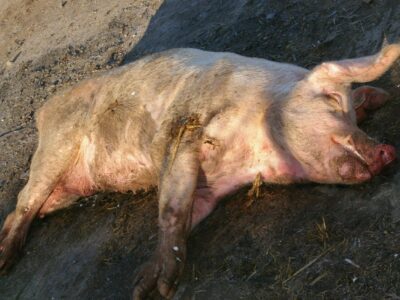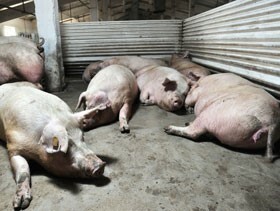



AASV: State veterinarians share lessons from disease outbreaks for pig industry
Those lessons included: planning, depopulation and quarantinesThree state veterinarians spoke at the American Association of Swine Veterinarians conference in March on foreign animal disease (FAD) preparedness and response. In the discussion, comparisons were made with battling past and current avian influenza outbreaks.
Plan ahead

Jeff Kaisand, DVM, Iowa Department of Agriculture and Land Stewardship, said that producers need to be engaged with their state veterinarian and other officials in the state in figuring out what the plans are for dealing with disease outbreaks in the state. He mentioned that there’s a group of swine states that regularly communicate with each other “on everything from permitting to what happens during the disease outbreak to trying to make sure that we're having as unified and uniform an approach to diseases as we can.”
Beth Thompson, DVM, Minnesota State Veterinarian, noted that it’s important to understand what goes on in the other states. State animal health officials talk to each other all the time. When it comes to disease response, everybody comes together and shares ideas, she said.
Bret Marsh, DVM, Indiana State Board of Animal Health, said that he’s been encouraged over the last 20 years on the efforts made by pig producers on improvement plans, advance planning and coordinating surveillance and traceability, among other things.
“There’s a lot of pieces and parts — we need to consolidate those so that we don't create producer fatigue,” said Marsh. He noted that we don’t want to have producers asking, “what is it you want me to do today?”
Kaisand of Iowa added that a huge lesson learned from the highly pathogenic avian influenza (HPAI) outbreak of 2015-2016 was that no one was looking forward to when and where the next outbreak would happen. He cautioned pig producers to start that planning now.

Depopulation
“One of the things that I think is fundamentally different between the poultry and swine industry, and my experience in this incident in Indiana, is that the poultry industry is depopulating their own birds. And that's what's making the difference,” said Marsh, referring to the HPAI outbreak that was just then starting to move across the country.
Poultry producers had started depopulating and disposing of the birds on-site within a matter of hours, according to Marsh.
“Can the swine industry do the same? Not today. And that's really the challenge,” he emphasized. “And that's really the task as I see it, because in the final analysis, that's what made the difference for us in southwest Indiana in the end, is that the companies themselves have learned how to foam birds.”

Depopulation in the swine industry is difficult because there’s no place for the pigs to go, Marsh said. “The Covid experience wasn't a disease of swine, but we found out pretty quickly how fragile that system really is. So, we ended up taking a look and making some hard choices on farms throughout the upper Midwest and depopulation.”
Iowa’s Kaisand said, “dead birds don't make more virus and they don’t keep laying eggs. If you have layers and they become infected, we can’t depopulate that 5-million-layer operation very quickly. They keep laying eggs, so you add more product that you have to dispose of. But the bigger issue of the day is dead animals don’t make more virus, that means less virus in the environment to clean up, which means less animals that are infected and [reduces] whatever your virus load is.”
The fewer animals that have the virus, the better off you are, said Kaisand.
“So as to mass depopulation and disposal on farm, … have a plan to do that. In Iowa, we're not letting anything leave an infected farm. Everything stays on the farm, so producers need to understand how to dispose of animals on-farm. That’s because we don’t want you trucking disease down the road ever again,” said Kaisand.

Kaisand mentioned that swine producers need to understand that process of burial, including shallow burial, as well as the composting process.
“It's going to be in all our best interest that we find farms that are infected quickly because that's going to help stop the spread of disease,” said Kaisand.
Indiana’s Marsh emphasized that the difference between the 2015-2016 and 2022 HPAI outbreaks is that poultry companies have now equipped themselves to cull and dispose of the infected flocks. He noted that the USDA will pay producers to do that work.
Marsh’s big concern for the swine industry is that if the US gets African swine fever, pig producers will just wait for the state veterinarian to show up to depopulate, for example, a 10,000-sow center or a 5,000-head finishing floor. If so, said Marsh, producers are going to be waiting a very long time.
“We need to be thinking about how to engage our producers and that thought process, not that someone’s coming to do it, but how would you go about it on your own sites,” Marsh added.
That’s why states need to offer a full suite of depopulation options for pig producers. There are several methods available, including foam, CO2, ventilation shutdown, and other options. Pig producers must have a plan for their operation, said Marsh.
Minnesota’s Thompson said that in the case of smaller finishing pig operations, there may not be much space for depopulation disposal to take place. Producers need to be thinking about possible options right now. That may include having to buy some land from surrounding landowners.
“During a foreign animal disease, we really don’t want these carcasses to leave the property,” Thompson said.
Quarantine

Something producers should be thinking about is quarantine, said Kaisand. “What does quarantine mean to the farm?” You’ll have the quarantined infected farm and then everybody else that's quarantined in that area, he said.
During a foreign disease outbreak, there’s a quarantine at the affected site, then a 10-kilometer (6.2-mile) control area is established around the affected site. Consider how many other producers are in that radius, “trying to stay in business and stay clean,” said Marsh. “Those control areas get to be really critical.”
In the case of poultry, Marsh said, once the birds are depopulated on the infected site, there are many other producers trying to save their animals, plus trade implications, including state-to-state and even international trade.
Pig producers in the quarantined area need to be ready to have permits that allow the safe movement of animals, Marsh noted. “Because if you’re going to move things around you’ve got to be safe,” he said.
Marsh is very appreciative of everyone in the swine industry for the strong support in getting their production sites put on the map. Because whether it's avian influenza or African swine fever, “just knowing in advance where these animals are is really, really critical. And then you begin to establish what needs to be done for those who are in control areas so they can continue to move product safely. That's all a permitting process. Then we establish an additional area with surveillance around that with additional testing, trying to make sure that we satisfy both our domestic and international trading partners with our animals,” Marsh concluded.
Thompson mentioned the Secure Pork Supply Plan. She said, at top of the list, “make sure you have the plan, and make sure it’s current with premises and ID numbers.”
Thompson also emphasized the critical importance of biosecurity, calling it “the silent hero.”
“In January, February, my driving skills are much better. Because there's a lot of ice, there's a lot of snow in Minnesota. So, I tend to increase that distance between me and the next car. I can slow down a little bit. That's what we have to think about with biosecurity, rather than just thinking about, ‘we’ve got African swine fever in the hemisphere, we’d better tighten up our biosecurity,’ we really shouldn't be doing that.”
Biosecurity must be “good, better, best all the time. We really should be doing those things that would be in place during a foreign animal disease event all the time,” Thompson concluded.









